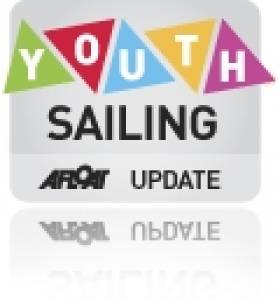Displaying items by tag: ISORA
ISORA Race 5 Tracker Isle of Man to Dun Laoghaire Here!
#isora – ISORA's Race five's 100–miler from the Manx port of Douglas to Dun Laoghaire starts at 0630 hours. Follow the race tracker above.
ISORA Holyhead – Douglas Race Tracker Live Here!
#ISORA – Race 4 - from Holyhead to Douglas, Isle of Man starts on Friday evening at 1915 hrs and the night race will provide many challenges for the fleet with the decision taken by the Organising Authority to declare the Traffic Separation Scheme (TSS) to the north of Skerries an exclusion zone.
TIME OF START FOR ALL CLASSES
19.10 Warning signal - Class flags (Numerals 1 & 2) hoisted
19.11 Preparatory Signal - Blue Peter hoisted
19.14 Blue Peter down
19.15 Start – Class flags down
The start may be broadcast on VHF Channel 37 (M1)
STARTING LINE
The start line shall be between the end of the Holyhead breakwater and the Clippera Buoy – 0.6 miles off pier head, bearing 067(T).
THE COURSE (approx 60 miles)
Start – Holyhead
Course to be decided
Finish – Douglas IOM
The course is approximately 60 mile long. The course will be posted on the ISORA website, texted and emailed to all entries and shall be available on Thursday morning 21st May. The course shall be broadcast on VHF Channel 37 (M1) before the start.
WAYPOINT MARKS
Waypoints may be used as marks. If so, Rule 28 will be amended accordingly in accordance with the RYA / RORC Guidance – "Racing Around Waypoints" See website for details
Evidence of rounding the "virtual" mark must be taken and may be requested by the Race Officer.
This evidence may include:
Photographic (iPhone or similar) evidence of the yacht's GPS showing its position at the mark.
Yacht's chart plotter track showing the yacht rounding the "virtual" mark. This must be
transmittable to ISORA by email.
The onus of proof of having rounded the WAYPOINT mark will be with each yacht.
Avery Crest YB TRACKER
The first 20 boats entered in the race will be fitted with the Avery Crest YB Tracker. The Skipper will have to sign an indemnity to cover the replacement cost of the unit in a situation that the unit gets lost or damaged.
The units can be collected from Peter Ryan at HSC on Friday evening at 17.30. The trackers will be set up for both races that weekend.
In order to set up the units all boats who are entered must declare that they are racing by 12.00 on Thursday 21st May. This declaration is a text to +353 87 2545037 stating that
"Boat name" will be racing on Saturday. This is critical for the efficient running of the tracking system.
The trackers must be returned to Peter Ryan in NYC immediately after the race on Sunday 24th May.
The tracking can be followed on the YB Tracking app for iPhones and Android. On downloading the app, the "ISORA Avery Crest 2015 Series" is purchased. This will give the purchaser full access to all races in the Series. ISORA will benefit from the sale of this app.
Any queries relating to the Avery Crest Trackers should be dealt with by contacting Peter Ryan +353 87 2545037.
FINISH LINE
Leaving channel mark No1 to Port, the finishing line shall be an extension of the line from the end of the Victoria Pier through the No3 Starboard Buoy to Onchan Head (See Chartlet). Boats approaching the finish shall radio "ISORA Finisher" on VHF Channel 6, 10 min before and then when passing between Green Fairway buoy and Breakwater Red.
The finish time and the time at each mark should be recorded in the log by each boat and text to ISORA at +353 87 2545037 as soon as possible after the race as the mandatory Declaration.
ISORA Sailors Set Sail for Isle of Man Offshore Weekend
#isora – No sooner is last night's DBSC racing over than some round–the–cans regulars are venturing outside the Bay this evening on a two–race ISORA weekend, with the Isle of Man as the focus. As David O'Brien reports in this morning's Irish Times Sailing Column the overall leader and defending champion Ruth (Liam Shanahan) has claimed a five point lead going into tonight's fourth race that has attracted a bumper fleet of over 20 that sees the focus of Irish sailing heading offshore this weekend.
The first race is tonight's 60–mile race four in the ISORA series from Holyhead in North Wales to the Isle of Man followed on Sunday by race five's 100–miler from the Manx port to Dun Laoghaire starting early at 0630 hours.
Overall, Shanahan's J109 from the National Yacht Club (NYC) leads Adrian Lee's Cookson 50 Lee Overlay Partners of the Royal St. George YC. The Pwllheli–based J109, Mojito is third. J boats occupy four of the top six places after three races and this weekend's forecast may also play into J hands.
As of this morning, the course for each race is likely to be direct from start to finish with light winds on offer and upwind a lot of upwind sailing predicted. This year's Avery–Crest sponsored series has the added attraction of satellite tracking that plots each competitors course, giving an extra dimension for race followers.
#isora – The Race 3 of the ISORA Avery Crest Offshore Series was very special as it was the first time that an ISORA Race was to be recorded using Yellow Brick (YB) satellite trackers that featured on Afloat's home page live during the race from Dun Laoghaire to Holyhead on Saturday. This 'huge step' for ISORA was facilitated by the generous sponsorship of "Avery Crest Ski Chalets Meribel" writes Peter Ryan, Chairman ISORA. Overall results after three races are available to download below.
The sponsorship allowed ISORA to acquire YB trackers to be used in all their races in the future. The use of the trackers brings the challenges and progress of offshore racing "right into your sitting room". In the past the fleet headed off from the start line and disappeared over the horizon, out of sight and unfortunately, out of mind. Now with the superb quality product, YB Trackers, all the boats taking part can be tracked and their progress followed by those left behind. As part of this leading tracking system, people can now download the YB Tracking app and buy the entire ISORA 2015 series of races for €2.99. All races can be replayed and analysed after the race in the comfort of your own home.
Of the 18 entries for the race, 17 came to the start line where National YC Commodore, Larry Power, sent the fleet off direct towards Holyhead at 08.05. The weather forecast for the race was not good since the beginning of the week. Earlier in the week the race promised to be run with very strong winds. However, as the week developed, a window of opportunity opened in the forecast to allow nearly perfect conditions for the race. This window was to close by early Sunday morning when again strong southerly winds were expected on the Irish Sea. With this limited window of opportunity available, the Sailing Committee decided to shorten the course to go direct to Holyhead.
![]()
A screenshot of the ISORA fleet race trackers used for the first time in Saturday's race from Dun Laoghaire to Holyhead. Click here for more
At the start, the winds were North westerly 10-12 knots. The forecast showed that a hole of "no wind" would develop close to the Irish coast by mid-day and it was vital that the fleet made progress away from the land immediately after the start. The fleet, lead by the Adrian Lee's Cookson 50 "Lee Overlay", sped under spinnaker out of the bay towards Holyhead. With the tide turning north just after the start, the fleet were pushed north.
Soon into the race, there was little sign of the "hole" appearing and the fleet sped towards Holyhead with an ETA of 15.30 for most of the fleet. In the fleet there were five J109s. "Jedi", now sailed two-handed got into some spinnaker hoist difficulties are the start and fell to the rear of the fleet. "Wakey Wakey" also had problems at the start and also fell towards the rear. The remaining three J109s, "Ruth", "Mojito" and "Sgrech" commenced a battle for position that went on for nearly five hours with less than a boat length between the three.
Then the "Hole" arrived!! The fleet slowed down to a near halt. This was made worse by the significant "lop" on the sea, making progress very difficult. "Lee Overlay" who sped away from the fleet after the start, appeared to have sailed very north and probably around the hole. They make cracking progress sailing a most northerly course until due north of the Skerries. There they gybed into a strong foul tide but heading for the finish line in Holyhead.
The remainder of the fleet were caught in the "hole" and all progress stopped for approximately two hours. Two handed "Bam" and J109, "Ruth", were first to break and head off at speed towards Holyhead followed eventually by the fleet.
On the approach to Holyhead, many of the fleet underestimated the strength of the south going tide cross the mouth of the harbour and, while only slightly below the course to the end of the breakwater, got trapped in the tide and made very little progress toward the end of the pier end. This "faux pas" allowed the main fleet to regain contact with the leading part of the fleet.
"Lee Overlay" had an easy passage, crossing the finish line at Holyhead at 14.26 and turned on the line to head back to Dun Laoghaire. The next boat to arrive was "Bam" at 17.00. The last boat to cross the finish Line, manned by Dawn Russell of Holyhead sailing Club, was "Lady Rowena" at 19.33. At this stage "Lee Overlay" had nearly arrived back to its berth in Dun Laoghaire marina.
Adrian Lee's " Lee Overlay" took an easy overall and Class 1 win on his first cross channel in ISORA since his return to racing in the Irish Sea. David Simpson's Swan "Albireo" took Class 2 and Silver Class. The downwind racing did not suit the J's with "Ruth" taking 3rd place overall behind "Bam".
The next two races involve a weekend of offshore racing with a race from Holyhead to Douglas on Friday evening, 22nd May, followed by a second race starting early Sunday morning 23rd May from Douglas to Dun Laoghaire. These races can be followed by downloading the YB tracking app or on the tracker viewer on the ISORA website www.isora.org .
These are exciting times for ISORA. The use of the YB trackers is a critical cog in the progress and development of offshore racing in these waters.
#isora – Today's ISORA offshore race has been confirmed as starting at the DBSC Pier Mark on Dublin Bay with a direct to finish at Holyhead, a distance of some 54–nautical miles. Follow the race on the tracker above. Winds are forecast to be light for the crossing, west to north west in direction and no more than 12 knots. Stroner winds from the south are due this evening. The reigning ISORA champion Ruth skippered by Liam Shanahan was the winner of April's first race coastal race of the season, a fortnight ago and is racing again this morning. Today's race features 18 starters made up of 13 from the Irish offshore fleet and five welsh boats. The start time is 0800 hours. More information and a copy of the sailing instructions is here.
#isora – Racing under the burgee of the National Yacht Club, the third race in the Irish Sea Offshore Racing Association (ISORA) 2015 series will start from Scotsman's Bay on the south side of Dublin Bay early on Saturday morning. The Irish offshore fleet is fitted with yellowbrick trackers for the 60–mile race across the Irish Sea from Dun Laoghaire to Holyhead, an important warm up for next month's Dun Laoghaire to Dingle race, also from the NYC.
The reigning ISORA champion Ruth skippered by Liam Shanahan was the winner of April's first race coastal race of the season, a fortnight ago. The NYC J–109 took a six minute win on corrected time from the Irish National Sailing Club Reflex 38 Lynx skippered by Kenneth Rumball. Third in that race was the Arklow Sailing Club J122, Aquelina.
ISORA Race three sailing instructions are downloadable below.
First ISORA Blood to J109 Ruth But Reflex 38 Lynx In Hot Pursuit
#isora – The reigning ISORA champion Ruth skippered by Liam Shanahan was the winner of today's first race coastal race of the 2015 season. The National Yacht Club J–109 took a six minute win on corrected time from the Irish National Sailing Club Reflex 38 Lynx skippered by Kenneth Rumball. Third in a buoyant 16–boat fleet was the Arklow Sailing Club J122, Aquelina (James Tyrrell). Results are downloadable below as a jpeg file.
Additional report from the Irish National Sailing School's Kenneth Rumball:
With much anticipation the Irish National Sailing School's new yacht Lynx, headed out for her first race on Saturday morning. The primary purpose of the purchase of the yacht Lynx for the Irish National Sailing School was to enable the growing centre to be able to deliver Royal Yachting Association and Irish Sailing Association cruising courses including Competent Crew, Dayskipper and Yachtmaster Courses to which the centre has gained recognition for the upcoming season. However with manager, Kenneth Rumball's varied racing background, the yacht purchased also needed to be able to deliver on a racecourse, hence the purchase of Lynx, a Reflex 38 originally successfully campaigned by Martin Breen.
Saturday's race was the first Irish Sea Offshore Racing Association race of 2015, originally planned as trip down to North Arklow, with a varied forecast for the Saturday, a decision on Friday was made to change the course to a trip south as far as Breaches Shoal, then north to East Kish before passing the Kish light and finishing at the pier heads. The crew on board Lynx included the INSS's Kenneth Rumball as skipper with experienced offshore sailors Keith Kiernan and James Ryan, Luke Malcom as bowman and INSS instructors, Calum Paterson, Andrew Abbott, Gareth Boyle and Robin Jones.
The previous night's study of grib files showed a strong westerly to start with the wind going northerly and dying throughout the day... Actual conditions were a little different, a strong Northerly of 25kts saw the fleet off from a start line just off the East Pier. The J109 Ruth made the best start followed tightly by Bam the Sunfast 3600 and then Lynx racing. Along the first fetch to the Muglins, Lee Overlay Partners (Cookson 50) stormed ahead followed by Bam and Lynx having rolled Ruth on the fetch. At the Muglins, Ruth made a swift hoist and shot ahead of her competition, a delayed hoist on Lynx saw them follow in pursuit. It then became a drag race between Ruth and Lynx to Breachers Shoal with both boat revelling in the windy downwind conditions.
By Breachers Shoal, Lynx had reeled in Ruth and was only a few boat lengths behind her. A tough long upwind to the Kish allowed Lynx to pass Ruth and hold off the ever approaching Aquelina, a J122. Rounding the Kish, Lynx hoisted their A5 to head home to the harbour. Lynx managed to hold off Aquelina to take second across the line to the Cookson 50 Lee Overlay Partners. On corrected time the J109 Ruth took the first race, six minutes ahead of Lynx.
A great first race for Lynx and very much enjoyed by her crew, the boats only second time sailing since having been purchased by the INSS over the winter. We are very much looking forward to many days teaching both racing and winning races.
UCD Sailing Club Students To Race Offshore With ISORA Fleet
#ucd – ISORA, the Irish Sea Offshore racing body, has entered into an understanding with University College Dublin (UCD) Sailing Club to provide crew places on ISORA boats.
ISORA boss Peter Ryan says: "this innovative scheme will allow students to gain offshore experience and will further promote offshore racing within the sailing fraternity."
An ISORA pre-season talk about offshore racing will be held in the National Yacht Club at 17.30 this Friday, 17th April.
#isora – Yellowbrick (YB) satellite trackers will be fitted to ISORA offshore boats for the 2015 Irish offshore season transmitting critical boat data including boat speed and position for a series of races across the Irish Sea.
YB Tracking are responsible for tracking most of the classic and high profile offshore races all over the world inlcuding the Rolex Fastnet race.
ISORA Chairman, Peter Ryan said "I am delighted that the 'ISORA Avery Crest Ski sponsored Offshore Series 2015' can now be followed by our supporters at their yacht clubs, on a computer or even on their smart phones. Spectators will now be able to appreciate our experiences as we race in challenging conditions in keenly fought races as we cross the Irish Sea. This device will also provide us with additional safety information. "
The ISORA calendar attracts 20 to 30 boats for a series of offshore races across the Irish Sea.
Followers will be provided with a visual representation of the race on a computer generated chart with 'leader board' and league table.
New Yacht Sees 'Sailing in Dublin' Club on Crest of a Wave
#sid – Sailing in Dublin Club (SID Club) has just acquired an additional cruising boat to add to its growing fleet writes Jessica O'Donnell. Silver Wind, a 35ft Sun Odyssey boat, was purchased thanks to the assistance of a grant from the Government's Sports Capital scheme with the balance paid from Club funds. SID put together dedicated grant and boat acquisition sub-committees drawn from club members and they put much hard work into securing this important new acquisition. The new boat, which was purchased with the aim of increasing participation in sailing, has been enthusiastically welcomed by SID's growing club membership.
Since its foundation thirty years ago, Sailing in Dublin Club has gone from strength to strength and its current fleet includes Laser Vagos; Ruff Diamond, a Ruffian 23; Obsession, a Sigma 33 boat, and now an additional cruising boat, Silver Wind. As a sailing collective, SID offers wonderful opportunities for racing and cruising without someone having to own their own boat. Its volunteer ethos means that there is also a pool of members to also draw upon to help with, and therefore offering more opportunities to learn more about, boat maintenance.
SID regularly participates in the DBSC series of races throughout the year, races in the challenging Irish Offshore ISORA races as well as Regattas in Dun Laoghaire and elsewhere close to Dublin. The Club's cruising ambitions have grown impressively and in 2015 SID has an exciting cruising programme which will see members sail in cruises along the east, south and west coast of Ireland stopping off in the likes of Dunmore East, Crosshaven, Baltimore, Dingle and Galway along the way. There are also plenty of shorter cruises and days sails closer to home against the backdrop of stunning Dublin Bay. With the new boat, there is now even more comfort and enhanced features for members when cruising. This cruising aspect is only one part of a vibrant club that also has an active dinghy section so there is certainly something for everyone!
While not a sailing school, there is a strong emphasis in SID on encouraging members to up-skill through their participation in recognised sail training provided by sailing schools around Ireland and abroad. A volunteer Training Officer and training sub-committee regularly update members on the availability of approved sail training courses whether related to VHF, First Aid, Sea Survival skills, operating a powerboat or other relative subjects. Club members, too, are happy to share their skills with others on different rungs of the sailing ladder and such co-operation and opportunities for sailing development from competent crew to skippering is one of the Club's most attractive features.
As a small and friendly club, there are opportunities for socializing after sails and throughout the year at Club dinners, BBQs and other events. With two female Commodores in succession the Club is also leading the way in promoting 'women on the water'. SID's excellent value – the annual membership subscription is only €370 – and variety and extent of sailing opportunities has seen the Club's membership grow impressively year on year. New members are always welcome and for anyone who would like to avail of a Guest Sail with SID, they can do so by going to the Club's website www.sailingindublin.ie The cost of a Guest Sail is only €40 and is redeemable against full membership subscription should a person wish to join the Club. With the bright evenings and summer approaching it is definitely time to get out sailing! To find out more about SID and what it has to offer click www.sailingindublin.ie


























